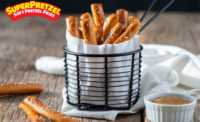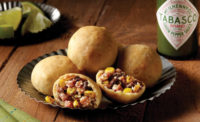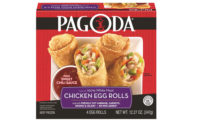State of the Industry 2018: Fueling growth of frozen snacks and appetizers
Nutrition, ethnic flavors and ingredient diversity can drive continued growth in frozen snacks and appetizers






Frozen snacks and appetizers are staples in most households—pizza rolls, for example, are a quintessential American snack. And the freezer case has been slowly evolving to meet consumers’ needs, branching out beyond typical heat-and-serve snacks.
Overview | Chips | Puffed/Extruded Snacks | Popcorn | Snack Mixes & Nuts | Tortilla Chips | Pretzels | Frozen Snacks | Crackers
Market data
According to data from IRI, Chicago, over the 52 weeks ending April 22, 2018, the frozen appetizers and snack rolls category saw a positive dollar sales increase of 5.98 percent to $2.3 billion. The subcategory of the same name is responsible for the lion’s share of the category and grew by 6.39 percent to $2.2 billion (frozen breaded vegetables add $27.0 million to the category, and the $75.6 million frozen soft pretzel segment is covered in our Pretzels article). All of the top five companies in the segment saw better performance for the current reporting period compared to a year ago.
The top two companies in the segment are anchored by single iconic brands. General Mills leads the segment with its Totino’s Pizza Rolls line, which grew 7.93 percent to $568.6 million and holds nearly 26 percent of segment share; the company overall was up 7.45 percent to $587.5 million. Ruiz Food Products owns the El Monterey brand, which grew 22.22 percent to $260.1 percent, while the company overall grew 21.91 percent to $261.8 million.
Private label also had a good year, up 15.92 percent to $197.9 million. Kraft Heinz also saw growth, up 8.36 percent to $176.0 million, with its Bagel Bites brand responsible for $158.9 million of that revenue, up 7.40 percent. Overall, Ajinomoto Windsor saw a slight dip, down 1.87 percent to $137.0 million, but its Ling Ling brand, which includes items like frozen potstickers and dumplings, grew 14.38 percent to $14.5 million.
Looking back
“The stigma of the freezer aisle seems to be waning as frozen snack makers are adapting to today’s consumer demands,” says Pam Stauffer, global marketing programs manager, Cargill, Minneapolis. “Clean label, organic, non-GMO, vegetarian, plant-sourced proteins—you can find it all in today’s frozen snack aisle.”
Millennials, in particular, are looking for something more from a heat-and-serve snack. “Millennials appear to have no stigma assigned to private label or store brands,” says Kristie Hung, marketing specialist, Sensient Natural Ingredients, Turlock, CA. “They care more about the flavor and ingredients used. In general, consumers are becoming more aware of what their food is made of, checking label claims and ingredient lists before making purchases. Hence, new products are accommodating consumers’ need for shorter ingredient lists with ‘real’ or recognizable healthy ingredients.”
In August 2017, Day-Lee Pride released three flavors of its new Umami Gyoza Dumplings: Chicken & Leek, Chicken & Shiitake and Pork & Leek. The dumplings have no preservatives, trans fats, artificial colors or added MSG.
Frozen breakfast handhelds continue to be popular, says Rachel P. Cullen, president and CEO, Ruiz Food Products, Inc., Dinuba, CA. Mintel’s “What’s for Breakfast—U.S.” study from July 2016 showed that for many consumers, the need for an on-the-go option for breakfast is paramount, and those consumers seeking a quick-frozen breakfast are interested in a wider variety of flavors, she adds. “In response to this trend, our El Monterey Simply Breakfast Egg, Turkey Sausage, and Cheese Burrito offers high protein and clean ingredients while still delivering great taste and convenience.”
People continue to replace meals with snacks, says Chef Jud McLester, executive chef and ingredient sales manager, McIlhenny Co./TABASCO Brand Products, Avery Island, LA. “The proliferation of snacking has reached the point of actual meal replacement. In combination with this rise in shareable portions, consumers are looking toward healthier alternative with cleaner label declarations.”
McLester notes bold flavors can sometimes help product developers improve nutritionals. “As consumers seek healthier snacks, bold flavors are used in place of salt, sugar and even fat.” TABASCO Original Red Sauce is aged for up to three years, giving it has natural umami characteristics that help elevate flavor profiles.
McLester also points toward ethnic flavor trends in frozen items. “Flavors commonly associated with India, Asia and Latin America are popping up in snacks, as consumers seek out ethnic fare.”
Authenticity is important with ethnic fare, says Chef Jason Gronlund, technical sales manager foodservice, Ardent Mills, Denver. “Consumers are looking for new ideas like British or Jamaican meat pies, which can either be larger for a grab-and-go snack or made in smaller versions for party appetizers.”
Farm Rich has been experimenting with new flavors, and in September 2017, it released Pimento Cheese Bites and Fiesta Chicken Roll Ups. The company also released frozen Avocado Slices, tossed in a potato stick coating flavored with ancho chiles.
“Chile peppers are often used to add an exciting layer to provide an adventurous flavor profile,” says Hung. “With the rise of globalization, millennials are genuinely interested in global cuisines and are increasingly willing to try new ethnic flavors.”
The frozen foods category is experiencing substantial growth for the first time in five years, says Janice Johnson, technical and applications service lead, Cargill Salt. “This trend, driven heavily by millennials, comes at a time when consumers are looking for healthful products combined with convenience.”
Looking forward
“Demand for ‘clean label’ products will remain a key focus for many of our customers,” says Shiva Elayedath, senior technical services manager, Cargill. The company’s new SimPure line of label-friendly, functional native starches can help manufacturers replace modified starches with minimal impact on cost, he says. “In particular, our SimPure 99560, a blend of potato and tapioca starches, and SimPure 99500, a potato starch, both have applications in frozen snacks and appetizers.”
Moving forward, frozen snack and appetizer producers can elevate flavor profiles by incorporating identifiable pieces of organic roasted chile peppers and organic smoked onion to communicate “all-natural freshness,” suggests Hung.
“Mediterranean, Asian and Mexican-styled frozen snacks and appetizers have been increasingly popular, especially with fusion options incorporating different types of ingredients,” says Hung. She suggests Umami Natural from Sensient Natural Ingredients to naturally add a meaty, savory flavor.
“Flexitarians are looking for transparent labels and an increased selection of plant-based proteins,” says McLester. “Combining this with adventurous ethnic flavor profiles could be a recipe for success.” He suggests experimenting with TABASCO Chipotle Pepper Sauce, since smoked flavor profiles have been trending.
Ingredients will continue to trend toward healthful and nutritious options, says Gronlund. “For instance, I’ve been amazed at the places cauliflower has gone. Who would think this humble, white vegetable would become a pizza or flatbread crust?” He notes that the potential to make frozen appetizers and handhelds more authentic and with slightly better nutrition is huge, and mixed grains, grain crisps and IQF grains can help manufacturers innovate with doughs, coatings and even stuffed frozen snacks.
“The Annex at Ardent Mills is developing many grains in IQF form—quinoa, farro, barley, White Sonora wheat—and they have so much potential in the tot/bite category of frozen snacks,” Gronlund says.
Just make those snacks and appetizers with quality ingredients, make them easy to heat—and, above all—make them tasty.
Overview | Chips | Puffed/Extruded Snacks | Popcorn | Snack Mixes & Nuts | Tortilla Chips | Pretzels | Frozen Snacks | Crackers
Looking for a reprint of this article?
From high-res PDFs to custom plaques, order your copy today!









